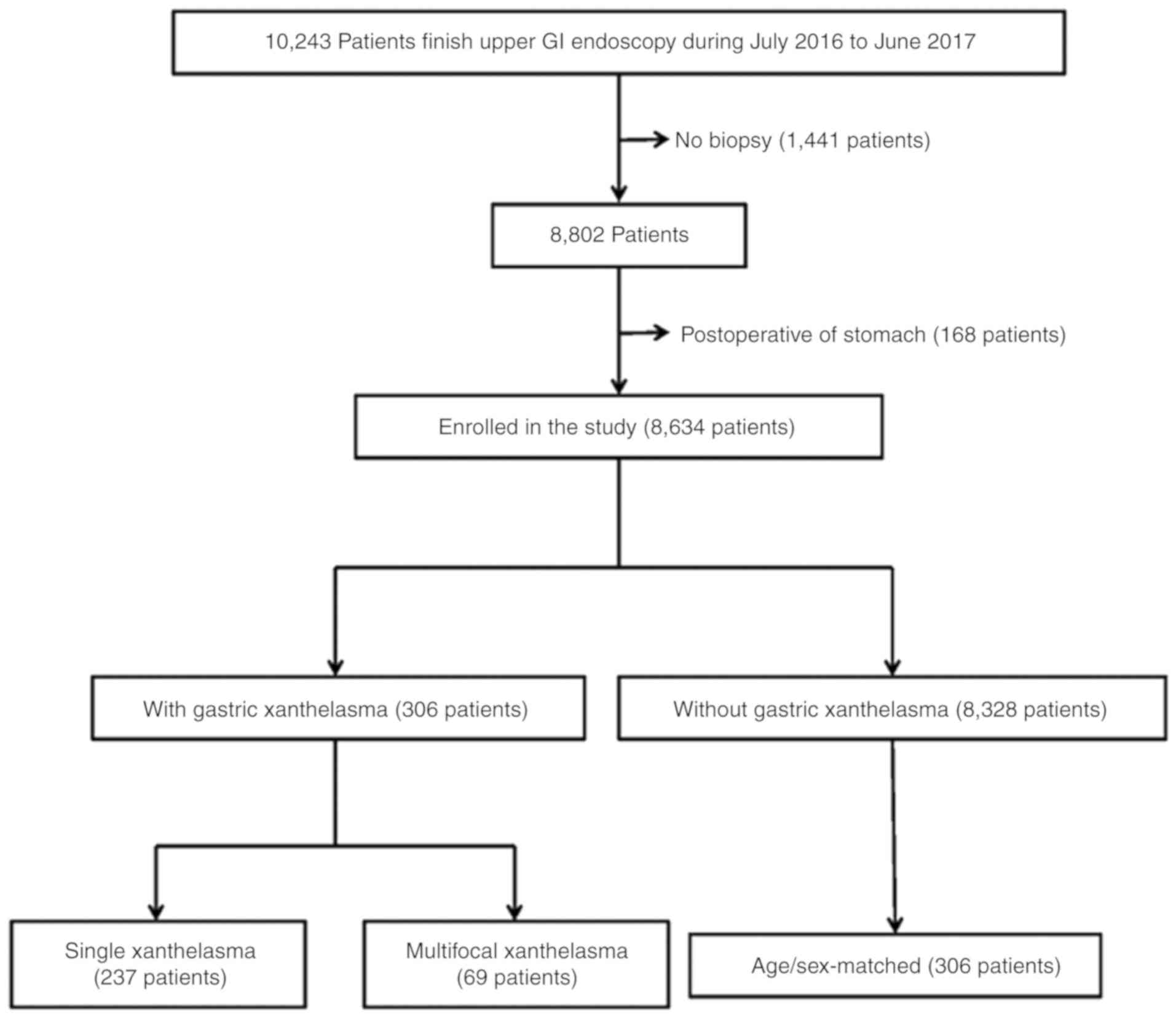|
1
|
Khachaturian T, Dinning JP and Earnest DL:
Gastric xanthelasma in a patient after partial gastrectomy. Am J
Gastroenterol. 93:1588–1589. 1998. View Article : Google Scholar : PubMed/NCBI
|
|
2
|
Kimura K, Hiramoto T and Buncher CR:
Gastric xanthelasma. Arch Pathol. 87:110–117. 1969.PubMed/NCBI
|
|
3
|
Coates AG, Nostrant TT, Wilson JA, Dobbins
WO III and Agha FP: Gastric xanthomatosis and cholestasis. A causal
relationship. Dig Dis Sci. 31:925–928. 1986. View Article : Google Scholar : PubMed/NCBI
|
|
4
|
Sekikawa A, Fukui H, Maruo T, Tsumura T,
Kanesaka T, Okabe Y and Osaki Y: Gastric xanthelasma may be a
warning sign for the presence of early gastric cancer. J
Gastroenterol Hepatol. 29:951–956. 2014. View Article : Google Scholar : PubMed/NCBI
|
|
5
|
Yi SY: Dyslipidemia and H pylori in
gastric xanthomatosis. World J Gastroenterol. 13:4598–4601. 2007.
View Article : Google Scholar : PubMed/NCBI
|
|
6
|
Gencosmanoglu R, Sen-Oran E,
Kurtkaya-Yapicier O and Tozun N: Xanthelasmas of the upper
gastrointestinal tract. J Gastroentero. 39:215–219. 2004.
View Article : Google Scholar
|
|
7
|
Petrov S, Churtchev J, Mitova R, Boyanova
L and Tarassov M: Xanthoma of the stomach-some morphometrical
peculiarities and scanning electron microscopy.
Hepatogastroenterology. 46:1220–1222. 1999.PubMed/NCBI
|
|
8
|
Chen YS, Lin JB, Dai KS, Deng BX, Xu LZ,
Lin CD and Jiang ZG: Gastric xanthelasma. Chin Med J (Engl).
102:639–643. 1989.PubMed/NCBI
|
|
9
|
Terruzzi V, Minoli G, Butti GC and Rossini
A: Gastric lipid islands in the gastric stump and in non-operated
stomach. Endoscopy. 12:58–62. 1980. View Article : Google Scholar : PubMed/NCBI
|
|
10
|
Chen Y, He XJ, Zhou MJ and Li YM: Gastric
xanthelasma and metabolic disorders: A large retrospective study
among Chinese population. World J Gastroenterol. 23:7756–7764.
2017. View Article : Google Scholar : PubMed/NCBI
|
|
11
|
Lechago J: Lipid islands of the stomach:
An insular issue? Gastroenterology. 110:630–632. 1996. View Article : Google Scholar : PubMed/NCBI
|
|
12
|
Hori S and Tsutsumi Y: Helicobacter
pylori infection in gastric xanthomas: Immunohistochemical
analysis of 145 lesions. Pathol Int. 46:589–593. 1996. View Article : Google Scholar : PubMed/NCBI
|
|
13
|
Köksal AŞ, Suna N, Kalkan İH, Eminler AT,
Sakaoğulları ŞZ, Turhan N, Saygılı F, Kuzu UB, Öztaş E and Parlak
E: Is gastric xanthelasma an alarming endoscopic marker for
advanced atrophic gastritis and intestinal metaplasia? Dig Dis Sci.
61:2949–2955. 2016. View Article : Google Scholar : PubMed/NCBI
|
|
14
|
Sekikawa A, Fukui H, Sada R, Fukuhara M,
Marui S, Tanke G, Endo M, Ohara Y, Matsuda F, Nakajima J, et al:
Gastric atrophy and xanthelasma are markers for predicting the
development of early gastric cancer. J Gastroenterol. 51:35–42.
2016. View Article : Google Scholar : PubMed/NCBI
|
|
15
|
Dixon MF, Genta RM, Yardley JH and Correa
P: Classification and grading of gastritis. The updated Sydney
System. International Workshop on the Histopathology of Gastritis,
Houston 1994. Am J Surg Pathol. 20:1161–1181. 1996. View Article : Google Scholar : PubMed/NCBI
|
|
16
|
Kitamura S, Muguruma N, Okamoto K,
Tanahashi T, Fukuya A, Tanaka K, Fujimoto D, Kimura T, Miyamoto H,
Bando Y, et al: Clinicopathological assessment of gastric xanthoma
as potential predictive marker of gastric cancer. Digestion.
96:199–206. 2017. View Article : Google Scholar : PubMed/NCBI
|
|
17
|
Isomoto H, Mizuta Y, Inoue K, Matsuo T,
Hayakawa T, Miyazaki M, Onita K, Takeshima F, Murase K, Shimokawa I
and Kohno S: A close relationship between Helicobacter
pylori infection and gastric xanthoma. Scand J Gastroenterol.
34:346–352. 1999. View Article : Google Scholar : PubMed/NCBI
|
|
18
|
Arévalo F and Cerrillo G: Gastric xantoma:
Histological findings and clinico endoscopic characteristics in the
‘Hospital Nacional 2 de Mayo’ (1999–2005). Rev Gastroenterol Peru.
25:268–271. 2005.(In Spanish). PubMed/NCBI
|
|
19
|
Moretó M, Ojembarrena E, Zaballa M, Tánago
JG, Ibáñez S and Setién F: Retrospective endoscopic analysis of
gastric xanthelasma in the non-operated stomach. Endoscopy.
17:210–211. 1985. View Article : Google Scholar : PubMed/NCBI
|
|
20
|
The Editorial Board of the Cancer
Statistics in Japan, . Cancer Statistics in Japan 2016. In:
Foundation for promotion of cancer research; Tokyo: pp. 922017
|
|
21
|
Du YQ, Cai QC, Liao Z, Fang J and Zhu CP:
China experts consensus on the protocol of early gastric cancer
screening (2017, Shanghai). Chin J Digest. 38:87–92. 2018.
|
|
22
|
Yao K, Uedo N, Muto M and Ishikawa H:
Development of an e-learning system for teaching endoscopists how
to diagnose early gastric cancer: Basic principles for improving
early detection. Gastric cancer. 20 (Suppl 1):S28–S38. 2017.
View Article : Google Scholar
|















